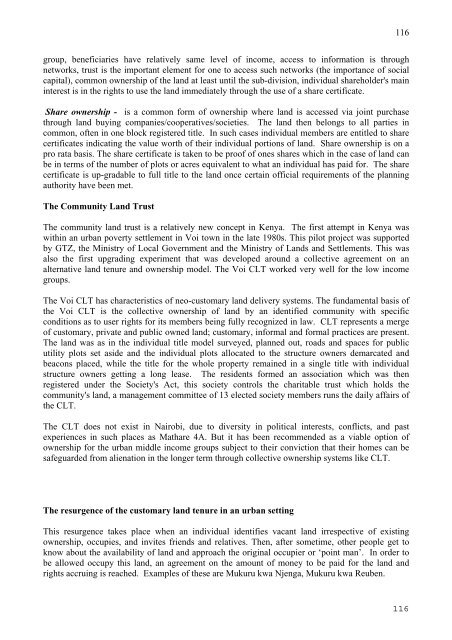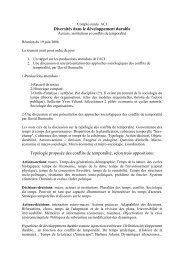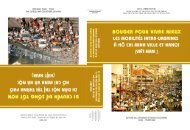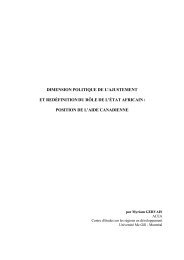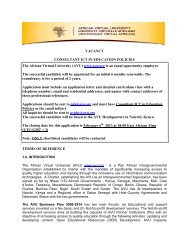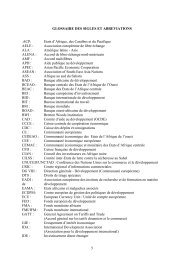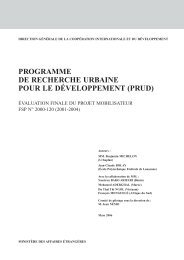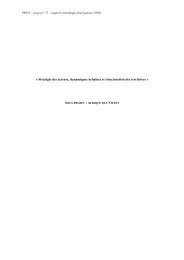Create successful ePaper yourself
Turn your PDF publications into a flip-book with our unique Google optimized e-Paper software.
116group, beneficiaries have relatively same <strong>le</strong>vel of income, access to information is throughnetworks, trust is the important e<strong>le</strong>ment for one to access such networks (the importance of socialcapital), common ownership of the land at <strong>le</strong>ast until the sub-division, individual shareholder's maininterest is in the rights to use the land immediately through the use of a share certificate.Share ownership - is a common form of ownership where land is accessed via joint purchasethrough land buying companies/cooperatives/societies. The land then belongs to all parties incommon, often in one block registered tit<strong>le</strong>. In such cases individual members are entit<strong>le</strong>d to sharecertificates indicating the value worth of their individual portions of land. Share ownership is on apro rata basis. The share certificate is taken to be proof of ones shares which in the case of land canbe in terms of the number of plots or acres equiva<strong>le</strong>nt to what an individual has paid for. The sharecertificate is up-gradab<strong>le</strong> to full tit<strong>le</strong> to the land once certain official requirements of the planningauthority have been met.The Community Land TrustThe community land trust is a relatively new concept in Kenya. The first attempt in Kenya waswithin an urban poverty sett<strong>le</strong>ment in Voi town in the late 1980s. This pilot project was supportedby GTZ, the Ministry of Local Government and the Ministry of Lands and Sett<strong>le</strong>ments. This wasalso the first upgrading experiment that was developed around a col<strong>le</strong>ctive agreement on analternative land tenure and ownership model. The Voi CLT worked very well for the low incomegroups.The Voi CLT has characteristics of neo-customary land delivery systems. The fundamental basis ofthe Voi CLT is the col<strong>le</strong>ctive ownership of land by an identified community with specificconditions as to user rights for its members being fully recognized in law. CLT represents a mergeof customary, private and public owned land; customary, informal and formal practices are present.The land was as in the individual tit<strong>le</strong> model surveyed, planned out, roads and spaces for publicutility plots set aside and the individual plots allocated to the structure owners demarcated andbeacons placed, whi<strong>le</strong> the tit<strong>le</strong> for the who<strong>le</strong> property remained in a sing<strong>le</strong> tit<strong>le</strong> with individualstructure owners getting a long <strong>le</strong>ase. The residents formed an association which was thenregistered under the Society's Act, this society controls the charitab<strong>le</strong> trust which holds thecommunity's land, a management committee of 13 e<strong>le</strong>cted society members runs the daily affairs ofthe CLT.The CLT does not exist in Nairobi, due to diversity in political interests, conflicts, and pastexperiences in such places as Mathare 4A. But it has been recommended as a viab<strong>le</strong> option ofownership for the urban midd<strong>le</strong> income groups subject to their conviction that their homes can besafeguarded from alienation in the longer term through col<strong>le</strong>ctive ownership systems like CLT.The resurgence of the customary land tenure in an urban settingThis resurgence takes place when an individual identifies vacant land irrespective of existingownership, occupies, and invites friends and relatives. Then, after sometime, other peop<strong>le</strong> get toknow about the availability of land and approach the original occupier or ‘point man’. In order tobe allowed occupy this land, an agreement on the amount of money to be paid for the land andrights accruing is reached. Examp<strong>le</strong>s of these are Mukuru kwa Njenga, Mukuru kwa Reuben.116


